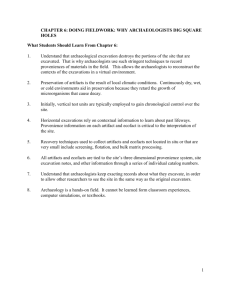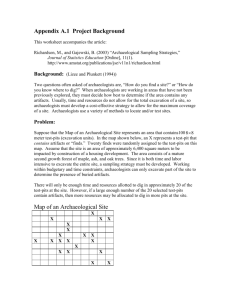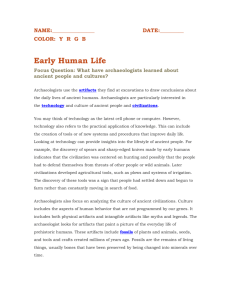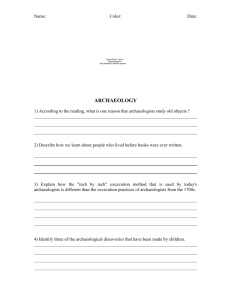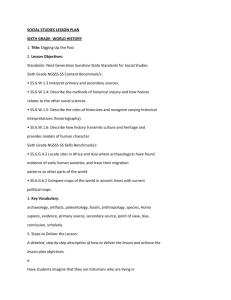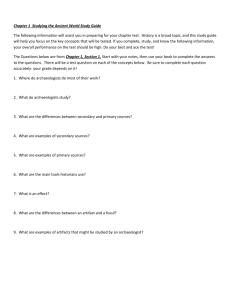Introduction to Archaeology Team Pegasus Ancient Civ. Name
advertisement
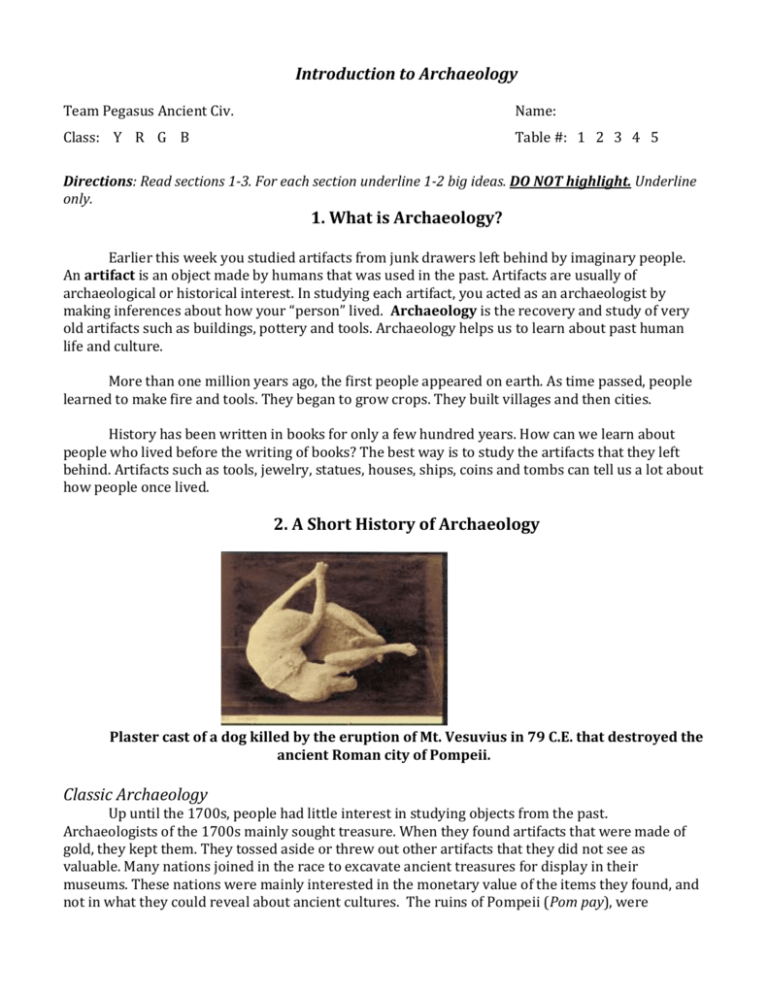
Introduction to Archaeology Team Pegasus Ancient Civ. Name: Class: Y R G B Table #: 1 2 3 4 5 Directions: Read sections 1-3. For each section underline 1-2 big ideas. DO NOT highlight. Underline only. 1. What is Archaeology? Earlier this week you studied artifacts from junk drawers left behind by imaginary people. An artifact is an object made by humans that was used in the past. Artifacts are usually of archaeological or historical interest. In studying each artifact, you acted as an archaeologist by making inferences about how your “person” lived. Archaeology is the recovery and study of very old artifacts such as buildings, pottery and tools. Archaeology helps us to learn about past human life and culture. More than one million years ago, the first people appeared on earth. As time passed, people learned to make fire and tools. They began to grow crops. They built villages and then cities. History has been written in books for only a few hundred years. How can we learn about people who lived before the writing of books? The best way is to study the artifacts that they left behind. Artifacts such as tools, jewelry, statues, houses, ships, coins and tombs can tell us a lot about how people once lived. 2. A Short History of Archaeology Plaster cast of a dog killed by the eruption of Mt. Vesuvius in 79 C.E. that destroyed the ancient Roman city of Pompeii. Classic Archaeology Up until the 1700s, people had little interest in studying objects from the past. Archaeologists of the 1700s mainly sought treasure. When they found artifacts that were made of gold, they kept them. They tossed aside or threw out other artifacts that they did not see as valuable. Many nations joined in the race to excavate ancient treasures for display in their museums. These nations were mainly interested in the monetary value of the items they found, and not in what they could reveal about ancient cultures. The ruins of Pompeii (Pom pay), were discovered for the first time in the late 1500s, but the discovery was not seen as very important and no excavation was done. An excavation is the organized process of digging up remains. In 1748 a farmer digging in a field in Italy struck an underground wall. A digging crew then unearthed the ancient city. It was Pompeii, and archaeologists soon discovered this ancient city, which had been destroyed nearly 1,700 years before. The excavation of Pompeii in 1748 was one of the first ever done in an organized way. Even after the excavation of Pompeii, many archaeologists of the 1700s still mainly sought treasure. BCE- Before Common Era (Anything before year 1 CE. 200 BCE would be 200 years before year 1, and 2214 years ago from today.) CE- Common Era (Anything after year I CE. Today we live in 2014 CE.) Modern Archaeology Since the beginning of the 20th century (1900s), however, archaeology has changed its focus. Most archaeologists no longer look only for beautiful and valuable objects. Today, archaeologists search instead to understand the lives of all people. Sir Flinders Petrie (1853-1942) was one of the first archaeologists to study everything he found. Petrie worked in Egypt during the late 1800s. When Petrie dug, he searched the earth “inch by inch”, as he described it. Petrie found pottery, tools and other items used by the Egyptians in their daily lives. Because he worked so carefully, Petrie is called the “father of modern archaeology”. Learning from Petrie, many modern archaeologists now study all things that early humans left behind. As a matter of fact, archaeologists today study ancient people’s rubbish. This rubbish, known as kitchen midden, often contains artifacts, bones and other evidence of early human settlement. Archaeologists study kitchen midden to learn important information about diet, daily activity, and contact with other cultures. 3. Knowing Where to Look The world is a big place. How do archaeologists know where to look for ancient artifacts? They don’t guess. Like detectives, they search for clues. Old books and writings often provide good clues. The Bible, the works of Homer, and other manuscripts describe ancient towns. Some of those towns are still there—buried under layers of dirt. Archaeologists study these books to determine where the ancient sites may be located. History before the development of writing is called prehistory. Archaeologists who study prehistoric times often rely not only on artifacts, but also on other non-written sources such as fossils and oral tradition to help them decide where to excavate. Fossils are the remains of onceliving plants or animals. If fossils of valuable plants or animals are found together in a place, archaeologists may assume that people used those plants and animals as resources, and may choose to dig in that area. Oral tradition is the legends, beliefs and traditions passed on by word of mouth from generation to generation, to help them understand the past. People may tell the story of a sunken ship. Archaeologists would listen to such stories for clues about that ship’s location.


